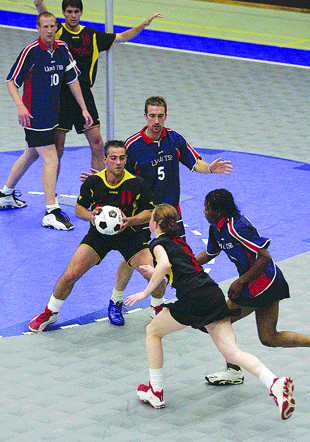By Vicki Kellaway
“Holland. When the waters rise, it’ll be the first place to go.”
That’s the standard reply of any European when asked about the effects of global warming. Holland, they joke, where 60 percent of people live below sea level, will be the first casualty.
The country’s fame may be based on cheese, legalized cannabis and an average national soccer team but perhaps it will eventually be remembered for a lesser-heralded feat. The fact that it launched a little known mixed-sex basketball-type sport into being worldwide — a sport called korfball that has just spent two weeks touring the United States.
The game was invented in Holland, more than 100 years ago, and imaginatively named after the Dutch word for basket. Its creator, Nico Broekhuysen, was a frustrated schoolteacher who needed a sport his male and female students could play together in the restrictive times of 1902. Dr. James Naismith had already created basketball some 11 years earlier but this had little effect on the Dutchman, who needed a mixed-sex spin to his sport.
Broekhuysen’s invention, now played in more than 30 countries worldwide, was very like Naismith’s — except the Dutchman’s students were not allowed to dribble.
Instead, they passed the ball from hand to hand but were rooted to the spot — unable to move with the ball.
They could take as long as they liked to pass to one another — but it was to their disadvantage to wait. They could only shoot when they had created at least a meter’s space from their opponent — who had to be the same sex as them.
Every korfball team, of which there are now thousands across the globe, includes four female players and four male players. Teams are divided into four attackers and four defenders, and a leather ball — a lighter version of a soccer ball — is used.
Defenders spend the game chasing attackers who attempt to make enough space to legally score — often taking shots 8 to 10 meters from the 12-foot-high goal.
The goal itself, the korf, is the sport’s unique selling point — well, it was until the wicker, laundry-style basket was replaced by a synthetic one more amenable to the game’s sponsors. This korf has no backboard and is set in from the court allowing players to run and shoot from behind it.
Korfball’s last deviation from its older, and commercially more successful, brother basketball is that players must rotate roles, from attacker to defender, every time two goals are scored. Players themselves are a mixed bunch, ranging from the elite and excessively tall professionals — funded by their government’s sports scholarships rather than their clubs — to the legions of families who play the sport together every Sunday.
Families are korfball’s ethos. Though the sport also makes for smutty jokes about being the only one with mixed showering and nominates its top international players for Playboy, it’s essentially a clean family game.
Korfballers may grumble they are constantly overlooked by the Olympic Games but at least this has afforded them a unique cult following.
It will always be basketball’s poor cousin, but you only need play once to realize that korfball, at least, is certainly worth saving from the sea.

















